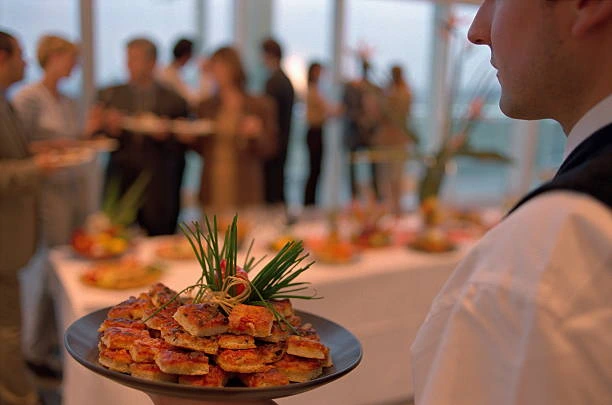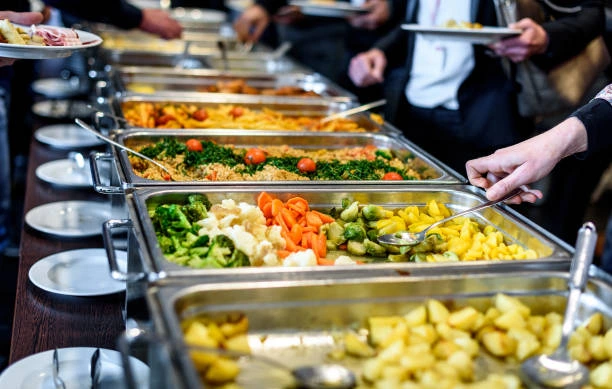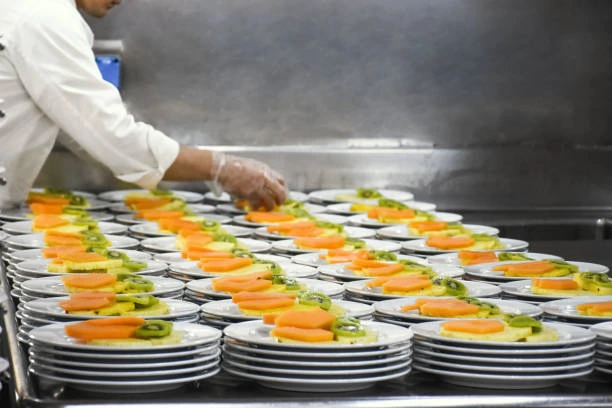How to Choose The Perfect Event Menu

When planning any event, the menu you choose is of the utmost importance. Your guests will remember an awful or delicious menu just as much as they will remember a great speaker. Choosing the right menu ensures your event goes off without a hitch and everyone enjoys their time there.
Additionally, when selecting your food, think about how it looks - presentation is important! A range of seasonal dishes and flavors can combine to create an exciting yet balanced menu that will please all guests. Consider different cuisines and styles of service; buffet-style meals are often popular, but food stations or platters can be fun too!
Elements to Consider When Selecting the Menu

Choosing the menu for an event is an essential part of its success. Before you decide what to serve, consider the type of event you are holding and the guest list. For example, a networking reception should be less formal than an awards banquet dinner, with more passed hors d'oeuvres and drinks rather than a full sit-down meal. If it's a dinner, consider how many courses you want to offer and if there will be a special presentation or speeches requiring additional food service time.
Additionally, consider any dietary restrictions of your guests when selecting dishes. It is also helpful to ask for feedback from attendees to ensure everyone will enjoy their meal. Finally, remember to include drinks as part of your menu selection. Whether they are alcoholic or not, a wide range of drinks is always a people pleaser.
Plan your Dishes Carefully
Choose carefully curated dishes to please your guests and meet their expectations. Consider the time of year; seasonal meals are also an easier menu choice. If you have yet to decide on a specific meal, go with what is popular during the season you are holding the event. When planning menu items, different types of cuisines are also always a fun choice to choose from as well. Still consider your demographic to ensure they will enjoy, but adding a fun dish from a different cuisine adds a special touch people will enjoy. Furthermore, ensure that your food selection complements the beverage options.
Considering all these factors when selecting your event menu, you can be sure it will be an unforgettable experience for everyone involved.
Consider your Event's Demographic
Consider the demographic attending when planning your food menu. Knowing who the guests are will help you decide on a menu that best suits their needs. For example, older demographics tend to prefer traditional food, while younger generations typically have diverse dietary requirements such as vegetarian, vegan, gluten-free, and dairy-free options. For example, a substantial menu catering to all tastes is recommended if you're hosting a college ball. Additionally, it is important to consider any religious restrictions that may be present when creating your menu –for instance, halal and Kosher diets – so always print dietary requirements on the menu for guests to refer to.
Stay on Theme
The menu should be tailored to suit the occasion when planning a themed event. For instance, if you are hosting a sports-themed event, BBQ, tacos, beer, and pub grub might be your best options. On the other hand, if you launch a new natural skincare line, rosehip tea and cucumber finger sandwiches might make more sense. Brainstorming with your team can help determine the perfect menu for your event. Although extra work if you need help matching food to your theme, you may want to poll your guests beforehand to get feedback on what they want to eat.
Consider balancing savory dishes with sweet treats or incorporating drinks that fit the bill. Adding small details to your food menu that matches your theme always makes a good impression on guests and gives them something extra to remember! You can create the perfect event menu with thoughtful consideration of your theme and guest feedback!
Style of Service

When planning an event menu, it is important to consider the style of service that best suits your occasion. For example, you may offer a table service style for a formal affair for a relaxed atmosphere. Alternatively, the buffet style allows guests to control their plates and encourages movement and networking opportunities. For those looking for more flexibility, à la carte options provide the most variety and are ideal for events with a shorter duration. If your event is longer, you may also want to consider built-in snack times or breaks and offer a cocktail hour with hors d'oeuvres.
Finally, if you plan on doing table service or passing hor d-oeuvres, ensure flawless service from your employees. This can make or break someone's experience based on the service they receive from the staff. By considering all of these factors, you can decide which style of service works best for your event.
When to Serve
When catering large-scale events, timing is of the utmost importance. Remember that plated meals require at least one and a half hours to serve if not two. This means guests don't want to be rushed while eating, so adequate time must be given for food to be plated, served, and cleared. It's important not to make the chef stick too strictly to a schedule either; catering for large-scale events can be very stressful on culinary teams!
Remember that allowing guests to choose from multiple options on a course can lead to longer serving times as well, considering your employees have to find out who ordered the dish at each table. This can get difficult, especially when serving 10-person banquet tables. Ultimately, when planning events, it's always best to give yourself more time than you think is necessary for your meal service – this will ensure your guests have the best experience possible.
Provide Sufficient Food
When planning a corporate event, one of the most important aspects is to provide sufficient food for all your guests. To ensure a successful event, knowing the exact number of people attending and consulting with your caterer about how much food will be enough for everyone is essential. If you fail to order enough food, you may be in an embarrassing situation when the caterer runs out of food during your event. This could leave your guests hungry and angry, ultimately ruining your whole event. Therefore, proper planning is key when selecting the menu for any corporate occasion.
Ensure you order enough food to feed all of your attendees while also considering any special dietary needs or restrictions they may have. One rule of thumb many caters use is adding 10% more to your food order. For example, instead of 100 people, they will cook for 110 people. This ensures enough food, especially if you are doing a buffet style or passing hor d'oeuvres where people can take more than what is considered to be one serving. These simple steps guarantee that everyone at your event will be well-fed and happy!
Consider Special Needs
Consider the unique needs of your guests, we touched on this when we spoke about your demographic, but this is a significant topic to ensure no one feels forgotten about. Ask your guests about any dietary restrictions or requests and accommodate them on your menu. This can be anything from vegetarianism to religious requirements or medical conditions that require avoiding certain foods.
You should always discuss these needs with your caterer so that they can plan for them accordingly. Additionally, make sure you have options available for people with food allergies or intolerances, such as gluten or dairy-free. This way, you can ensure your guests enjoy themselves without worrying about their dietary needs. By considering special needs and accommodating them to your dinner menu, you can create an enjoyable experience for everyone.
Stick to the Budget
When planning an event, sticking to a budget can be one of the most challenging parts. Fortunately, with some planning and research, you can have your dream event menu without breaking the bank.
Start by discussing your budget up front with your caterer when selecting dishes for your event. This will ensure they only present you with options within your price range. Don't be discouraged if some of the more expensive dishes are out of reach—plenty of delicious and impressive choices won't break the bank.
Your caterer can also help you choose dishes that match your affair and accommodate all guests' dietary needs without compromising taste or quality. Consider requesting sample tastings to decide which dishes best fit your event and budget.
Sticking to a budget doesn't mean settling for less-than-stellar food; it just takes a bit of creativity and planning to choose the perfect menu for any occasion. With the right caterer and helpful tips, you can create a fantastic event menu without exceeding your budget!
Food Presentation
The visual presentation of a meal plays a significant role in how much people enjoy it. Food and beverage should be presented to make them look appetizing. In fact, many chefs believe that aesthetics help people's appetite before they even taste the food. When plating a meal or setting up a buffet-style meal, decorations, tableware, linens, and other adornments should be chosen to help evoke an atmosphere that complements the meal's theme. The colors and shapes should work together so that when guests look at the dishes, their mouths start to water with anticipation!
Conclusion
A meal is a very important part of any event. Many look forward to seeing what is being served when attending an event. It is an extra exciting part of attending events. A menu may not be on the top of your list for many reasons, one being you want to make other things at your event you have worked hard planning to be in the spotlight, like an impressive guest speaker, or maybe you aren't interested in food or picky about what you eat. But it would be best if you considered the masses. Many enjoy and look forward to it. Imagine entering an event that only has water bottles and chips to offer. Whether you are a foodie or not, you would still be less than impressed.
Social  Your All-in-One Event Management Platform
Your All-in-One Event Management Platform
Host Events with Ease! Events.org's comprehensive event management platform makes it easy to optimize, automate and maximize your organization's entire charitable event calendar.Events.org Benefits:
✓ Simple, Affordable Pricing for Paid Events: $1 per Transaction!
✓ FREE Events are always FREE
✓ Host & Manage Any Event
✓ Dedicated Customer Support
✓ Branded Event & Donation Pages
✓ Donor and Contacts Management (CRM)
✓ Membership Management
✓ Conference Management
✓ Volunteer Management
BONUS: Free access to the iBid's Mobile Auction AutoPilot™ - This automation tool saves you time & stress while streamlining auction tasks. Manage auction items and payment processing, including express checkout & digital receipts!
